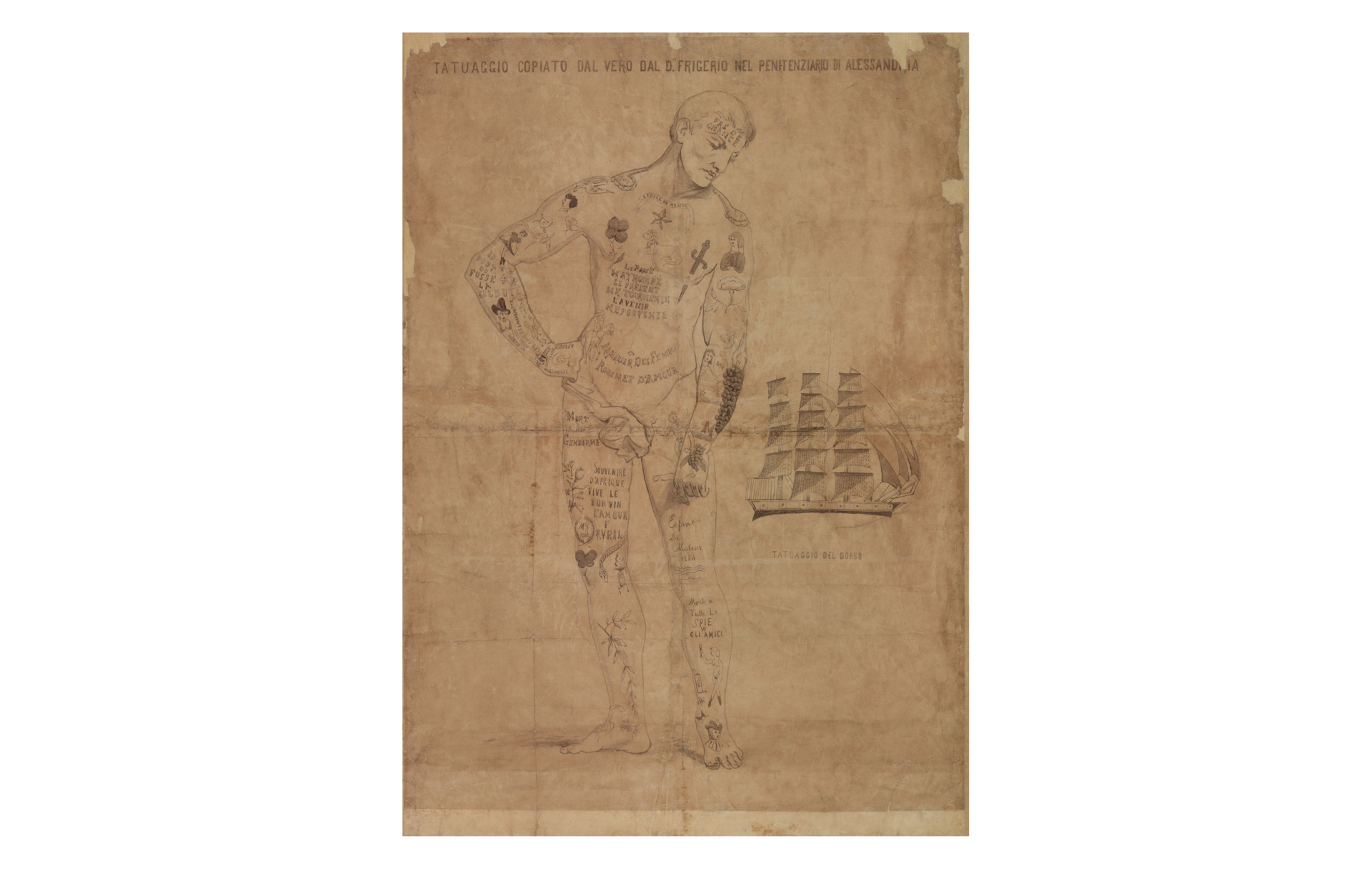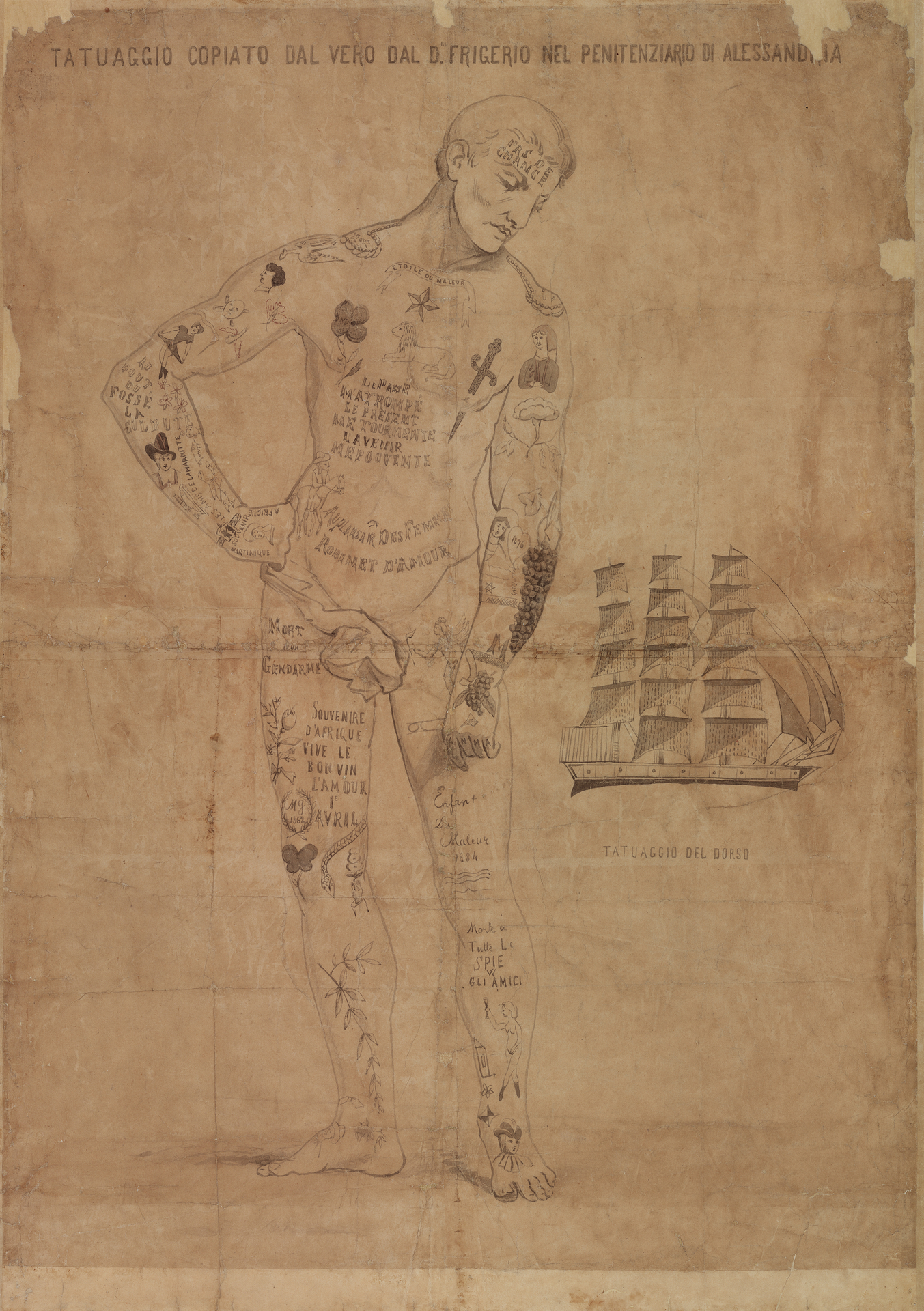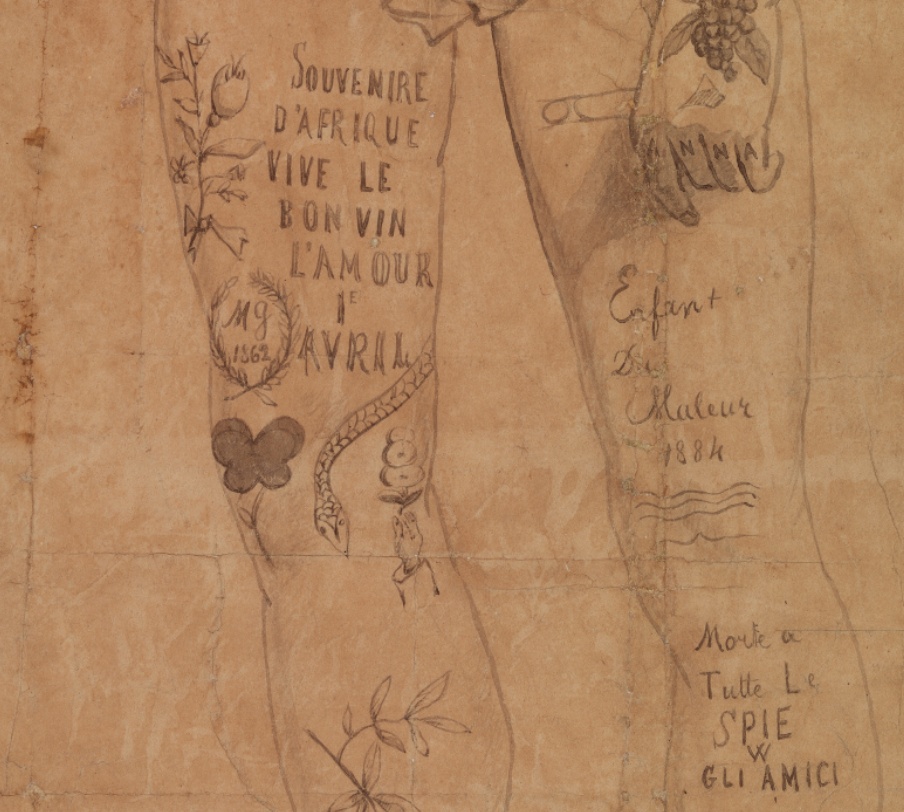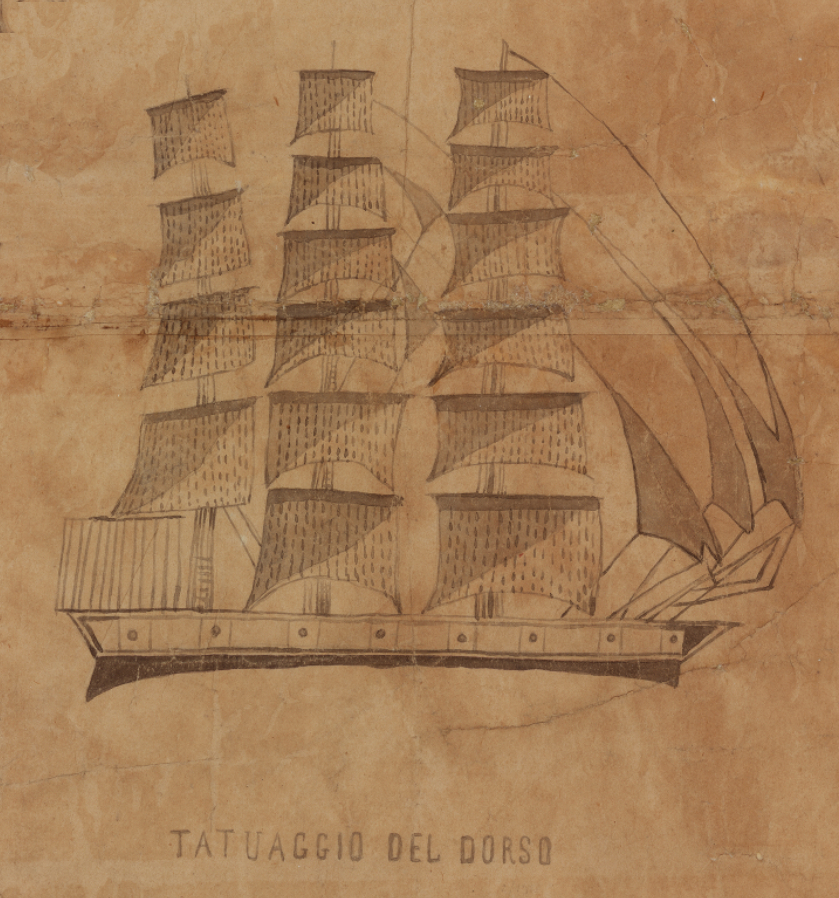Tattoo Drawing from Alessandria (Piedmont, Italy)
Beschreibung
The case study refers to Italy, in particular to the Tattoo Drawing Collection of the “Cesare Lombroso” Museum of Criminal Anthropology, University of Turin.
Cesare Lombroso (Verona, 1835 – Turin, 1909), psychiatrist and anthropologist, is considered the father of modern criminology. In Turin, Lombroso founded a new discipline, Criminal Anthropology, asserting that criminals possess distinctive somatic traits. In 1876, he published Criminal Man, a work that, with its five editions and several translations, would make him famous worldwide. In 1898, he inaugurated his Museum of Psychiatry and Criminology at the Palace of the Anatomical Institutes of the University of Turin, featuring collections of anatomical specimens, drawings, photographs, criminal evidence, writings, and both artisanal and artistic works—some of high value—created by asylum inmates and prisoners. These collections serve as evidence of his research and the extensive network of contacts he maintained with Italian and international psychiatrists, criminologists, and prison directors, who on various occasions sent him artifacts and documents to be displayed in his museum. Reopened in 2009, a hundred years after his death, the Museum now offers visitors a critical perspective and showcases the Lombrosian collections, testimonies of positivist science from the second half of the 19th century.
The panel presented hear shows either a real person (Giovanni Mullé) or can be a palimpsest of tattoos of different people. It’s commonplace to be an emblematic object of criminologists’ discovery of tattooing. It was exhibited for the first time in Rome in 1885, at the occasion of the first congress of Criminal Anthropology. Secondly it was sent to Paris, for the Universal Exhibition of 1889, into the anthropology section.
This document represents a double temporal dimension (the life of the French man who’s tattoos are portrayed and the research time of Lombroso) as well as two types of movements (the trips in Africa and in Martinique and the movements of his tattoos portrait in Rome and in Paris).
References:
- Cesare Lombroso (1887): L’homme criminel. Étude anthropologique et médico-légale, Félix Alcan – Bocca Fréres: Paris – Turin.
- Cesare Lombroso (1890): Les progrès récents de l’Anthropologie Criminelle, in: Centralblatt für Nervenheilkunde und Psychiatrie, XIII, I, June 1890, pp. 102-108.
- Cesare Lombroso (1894): Les palimpsestes des prisons, A. Storck – G. Masson: Lyon – Paris.
Cesare Lombroso (Verona, 1835 – Turin, 1909), psychiatrist and anthropologist, is considered the father of modern criminology. In Turin, Lombroso founded a new discipline, Criminal Anthropology, asserting that criminals possess distinctive somatic traits. In 1876, he published Criminal Man, a work that, with its five editions and several translations, would make him famous worldwide. In 1898, he inaugurated his Museum of Psychiatry and Criminology at the Palace of the Anatomical Institutes of the University of Turin, featuring collections of anatomical specimens, drawings, photographs, criminal evidence, writings, and both artisanal and artistic works—some of high value—created by asylum inmates and prisoners. These collections serve as evidence of his research and the extensive network of contacts he maintained with Italian and international psychiatrists, criminologists, and prison directors, who on various occasions sent him artifacts and documents to be displayed in his museum. Reopened in 2009, a hundred years after his death, the Museum now offers visitors a critical perspective and showcases the Lombrosian collections, testimonies of positivist science from the second half of the 19th century.
The panel presented hear shows either a real person (Giovanni Mullé) or can be a palimpsest of tattoos of different people. It’s commonplace to be an emblematic object of criminologists’ discovery of tattooing. It was exhibited for the first time in Rome in 1885, at the occasion of the first congress of Criminal Anthropology. Secondly it was sent to Paris, for the Universal Exhibition of 1889, into the anthropology section.
This document represents a double temporal dimension (the life of the French man who’s tattoos are portrayed and the research time of Lombroso) as well as two types of movements (the trips in Africa and in Martinique and the movements of his tattoos portrait in Rome and in Paris).
References:
- Cesare Lombroso (1887): L’homme criminel. Étude anthropologique et médico-légale, Félix Alcan – Bocca Fréres: Paris – Turin.
- Cesare Lombroso (1890): Les progrès récents de l’Anthropologie Criminelle, in: Centralblatt für Nervenheilkunde und Psychiatrie, XIII, I, June 1890, pp. 102-108.
- Cesare Lombroso (1894): Les palimpsestes des prisons, A. Storck – G. Masson: Lyon – Paris.
Kurzbeschreibung
The case study refers to Italy, in particular to the Tattoo Drawing Collection of the “Cesare Lombroso” Museum of Criminal Anthropology, University of Turin.
Cesare Lombroso (Verona, 1835 – Turin, 1909), psychiatrist and anthropologist, is considered the father of modern criminology. In Turin, Lombroso founded a new discipline, Criminal Anthropology, asserting that criminals possess distinctive somatic traits.
Cesare Lombroso (Verona, 1835 – Turin, 1909), psychiatrist and anthropologist, is considered the father of modern criminology. In Turin, Lombroso founded a new discipline, Criminal Anthropology, asserting that criminals possess distinctive somatic traits.
Thema
Cesare Lombroso, criminal anthropology, tattoos, atavism theory, prison
Beteiligte Personen und Organisationen
This drawing was created in the second half of the 19th century at the penitentiary of Alessandria (Piedmont) by Luigi Frigerio, a medical collaborator of Cesare Lombroso. The panel shows either a real person (Giovanni Mullé) or can be a palimpsest of tattoos of different people. It’s commonplace to be an emblematic object of criminologists’ discovery of tattooing. This panel was exhibited for the first time in Rome in 1885, at the occasion of the first congress of Criminal Anthropology. Secondly it was sent to Paris, for the Universal Exhibition of 1889, into the anthropology section.
Ort
Archives of the “Cesare Lombroso” Museum of criminal anthropology, University of Turin
Maße/Umfang
Entire object: 1360 x 960 mm
Sailing boat: 300 x 270 mm
Sailing boat: 300 x 270 mm
Material/Technik
Watercolor drawing on paper
Identifikator
Inventory number: 312
Förderung
Project: SciCoMove - Scientific Collections on the Move: Provincial Museums, Archives and Collecting Practices (1800-1950).
Funding: This project has received funding from the European Union’s Horizon 2020 research and innovation programme under the Marie Skłodowska-Curie grant agreement No 101007579.
The contents of this publication are the sole responsibility of the SciCoMove consortium and do not necessarily reflect the opinion of the European Union.
Funding: This project has received funding from the European Union’s Horizon 2020 research and innovation programme under the Marie Skłodowska-Curie grant agreement No 101007579.
The contents of this publication are the sole responsibility of the SciCoMove consortium and do not necessarily reflect the opinion of the European Union.
Dateien




Quellenangabe
„Tattoo Drawing from Alessandria (Piedmont, Italy),” SciCoMove, zuletzt aufgerufen am 1. Juli 2025, https://ausstellungen.deutsche-digitale-bibliothek.de/scicomove/items/show/20.
